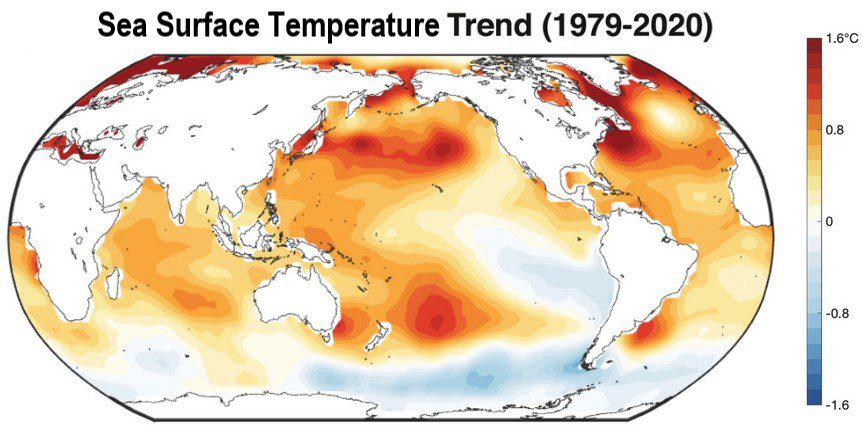You might have heard that forecasters are predicting this winter will see La Niña weather conditions peak for the third year in a row – something that’s only been reported two or three times since records began.
In a new study, scientists suggest this unusual turn of events may have come about, at least in some part, due to climate change.
The research found that the Pacific Ocean off South America has actually cooled slightly, despite warming global temperatures, while the western Pacific and eastern Indian Oceans have warmed more than elsewhere. The result is an increase in temperature difference between the eastern and western Pacific, creating stronger winds blowing toward Indonesia, which could be bolstering La Niña conditions.
“The Pacific Ocean naturally cycles between El Niño and La Niña conditions, but our work suggests that climate change could currently be weighing the dice toward La Niña,” Robert Jnglin Wills, lead study author and expert in atmospheric sciences at the University of Washington, said in a statement.
Temperatures in the tropical eastern Pacific Ocean rise and fall in a cycle known as the El Niño–Southern Oscillation. The cooling phase – with below-average sea surface temperatures across the east-central Pacific – is referred to as La Niña, which means “the girl” in Spanish. El Niño, meaning “the boy,” refers to the warm phase when the Pacific’s warmest surface waters sit offshore of northwestern South America. There is also a neutral stage that occurs in between phases.
These changes disrupt the wind, cloud, and pressure patterns over the Pacific, triggering a cascade of effects that can be seen in the weather across the globe. During a La Niña event, this includes drier conditions in East Africa, as well as wetter weather in Australia and parts of Southeast Asia.

Sea-surface temperature observations from 1979 to 2020 show that the surface of the Pacific Ocean has cooled off of South America and warmed off of Asia. Image credit: Wills et al./Geophysical Research Letters
While the current situation appears to have favored the emergence of a triple-dip La Niña, the researchers suspect that future climate change might tip the balance and start encouraging El Niño conditions.
This is because the cool water rising to the sea surface off South America will meet warmer air in the future. Since evaporation has a cooling effect, the chillier ocean off South America, which has less evaporation, will warm faster than the warmer ocean off Asia.
The decreased temperature difference between the western and eastern Pacific will reduce the winds blowing toward Indonesia, just as we see during El Niño. It’s known from past temperature records that El Niño-like patterns are more common during warmer periods.
As this study shows, the opposite seems to be occurring for the time being, although the reason is not crystal clear. However, this is all set to flip in the coming future.
“At some point, we expect anthropogenic or human-caused influences to reverse these trends and give El Niño the upper hand,” Wills added
There is still a lot of uncertainty around how the El Niño–Southern Oscillation will be impacted by climate change. Scientists have only been closely studying the frequency of El Niño and La Niña events in recent decades, so there’s still not a lot of data to go by. However, the few years could prove decisive on whether science finally has a solid understanding of this hugely influential phenomenon of nature.
“These year-to-year changes are very unpredictable and it’s important not to get too hung up on any individual year—it doesn’t add a lot of statistical weight,” Wills said
“If it turns out to be natural long-term cycles, maybe we can expect it to switch in the next five to 10 years, but if it is a long-term trend due to some processes that are not well represented in the climate models, then it would be longer. Some mechanisms have a switch that would happen over the next few decades, but others could be a century or longer,” added Wills.
The new study was published this week in the journal Geophysical Research Letters.
Source Link: Current "Triple-Dip" La Niña May Have Been Egged On By Climate Change